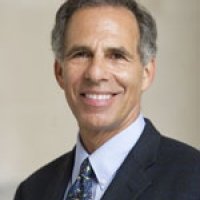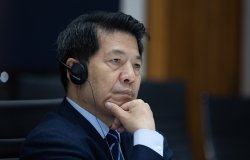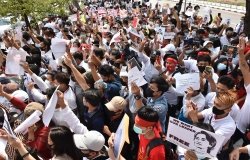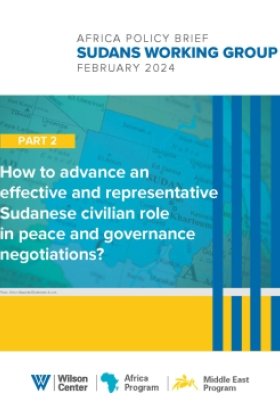The Security Demographic: Assessing the Evidence
Drawing on three decades of data, Richard Cincotta and Jack Goldstone explore the relationship between demography and conflict—critical to the USAID reexamination of the Fragile/Rebuilding States strategy.
Overview
As a country's birth and death rates shift from high to low, it is said to be moving through the "demographic transition." Countries that have completed this transition are less vulnerable to civil conflict, argued Population Action International's Richard Cincotta at the Environmental Change and Security Program's second meeting in its Health, Population, and Fragility series on June 13, 2006. Drawing on three decades of data, Cincotta and Jack Goldstone of George Mason University explored the relationship between demography and conflict—critical to the U.S. Agency for International Development's (USAID) reexamination of the Fragile/Rebuilding States strategy. Goldstone argued that due to this link with instability, the national security and development communities have a vested interest in helping societies move through the demographic transition to achieve the so-called "security demographic"—defined by Cincotta as "a set of stability-promoting demographic characteristics."
Demographic Transitions and Youth Bulges
Demographic transitions have occurred naturally and frequently throughout history, noted Goldstone. For example, the United States is experiencing the effects of its own demographic transition as the baby boomers begin to reach retirement age and challenge the country's ability to care for a large elderly population. In the developing world, however, the impact of such transitions can exacerbate or spur more serious problems, including civil conflict. In a country with a low natural growth rate, demographic increases often have little profound impact because the economy can generally grow to absorb the additional population. "Society [can] adapt over time to expanding numbers, without a sudden increase in demand for services," Goldstone said. However, in a country with high fertility and falling mortality, a large youth cohort may reach adulthood without giving the government a chance to adapt. Such a "youth bulge" can contribute to a catalog of problems in developing countries, particularly if government and civil society are unable to ensure basic services such as employment, housing, and education for the members of the larger cohort.
Goldstone argued that everyone—from parents to the courts, from the health system to the education system—is put under increased strain by youth bulges. "When you have that huge surge in surviving children, well, children need supervision, they need education, they need opportunities. They also need to be socialized into respect for existing law and order. If that doesn't happen, then they want to go off and find their own way," he said.
Youth Bulge and Civil Conflict
According to Cincotta, a society's propensity toward civil conflict increases if it cannot adequately accommodate youth bulges. Providing a brief overview of evidence supporting the connection between large youth populations and civil conflict, he showed charts of age distributions in Uganda, Angola, Chad, and the Solomon Islands. Each of these countries, he argued, has a predisposition toward civil conflict because of their common feature: greater than 50 percent of the population is between ages 15 and 24. Historically, he said, countries experiencing youth bulges were more likely to experience civil conflict, which, in modern times, has far outweighed the incidence of interstate conflict.
While youth bulges are not always destructive, they can be destabilizing if they exacerbate competition for already scarce jobs and opportunities to the point where the youth cohort begins searching for economic and social advancement through other avenues. "It is our conclusion that much of the risk that is generated by demographic factors has to do with the ease of recruitment, of recruiting mostly young males to extremist political organizations, to insurgencies, to state-supported regular and irregular security forces," Cincotta said. Increased membership in such groups—and the great competition between them—is an indicator of brewing unrest.
Other factors can exacerbate the negative impact of youth bulge, primarily rapid urbanization associated with extreme population growth. This dynamic creates conditions that support black market trade and other illegal activities, as well as compound shortages that may already exist. The black market, Cincotta said, has been linked to the rise of gangs and paramilitary movements, adding that parents and society often have great trouble mitigating the impact of "street culture" on young adults, which only exacerbates the problem.
The Role of Development Agencies
In Cincotta's experience, research on the connections between demographic changes and conflict has traditionally been presented to the national security community, not the development community. As a result, his work "purposely avoids what is called the human security rationale, but that doesn't mean that those rationales are illegitimate… The conflict project is about state security and state building because these are increasingly framing foreign policy funding and programming." Since the current political climate puts a premium on security, tying development to security is crucial. Demographic risk factors for conflict are clearly demonstrable, but often lose ground to a country's pressing political and social concerns: "The security community…is just preoccupied with short-term solutions," he said. Prioritizing health care and demographic development independently of a national security tie is further complicated by the fact that it is often difficult—if not impossible—to separate the economic causes of conflict from the demographic ones.
Development can mitigate and even eliminate the instability that normally accompanies demographic transition, according to Goldstone: "A rich society does have more scope. If you have a society like China where the economy is growing at 6 or 7 percent, they probably didn't need the one-child policy, although some of that rapid growth was precisely because their dependency ratio means that most of the population is adult and productive." He urged Western development professionals to help countries achieve their security demographic: "You can think of society as a very large multicellular organism, where the individuals are like the cells. A healthy organism grows at a normal rate and within proportion. The different parts of the body grow in proportion and it all functions well." If development agencies can promote that normal growth—and in the right proportion—civil conflict will be less likely, he concluded.
Drafted by Matthew Robinson.
Documents & Downloads
Speakers

Richard Cincotta
Demographer in Residence, The Stimson Center

Jack A. Goldstone
Virginia E. and John T. Hazel Professor of Public Policy, George Mason University; Wilson Center Fellow
Hosted By

Environmental Change and Security Program
The Environmental Change and Security Program (ECSP) explores the connections between environmental change, health, and population dynamics and their links to conflict, human insecurity, and foreign policy. Read more
Thank you for your interest in this event. Please send any feedback or questions to our Events staff.







